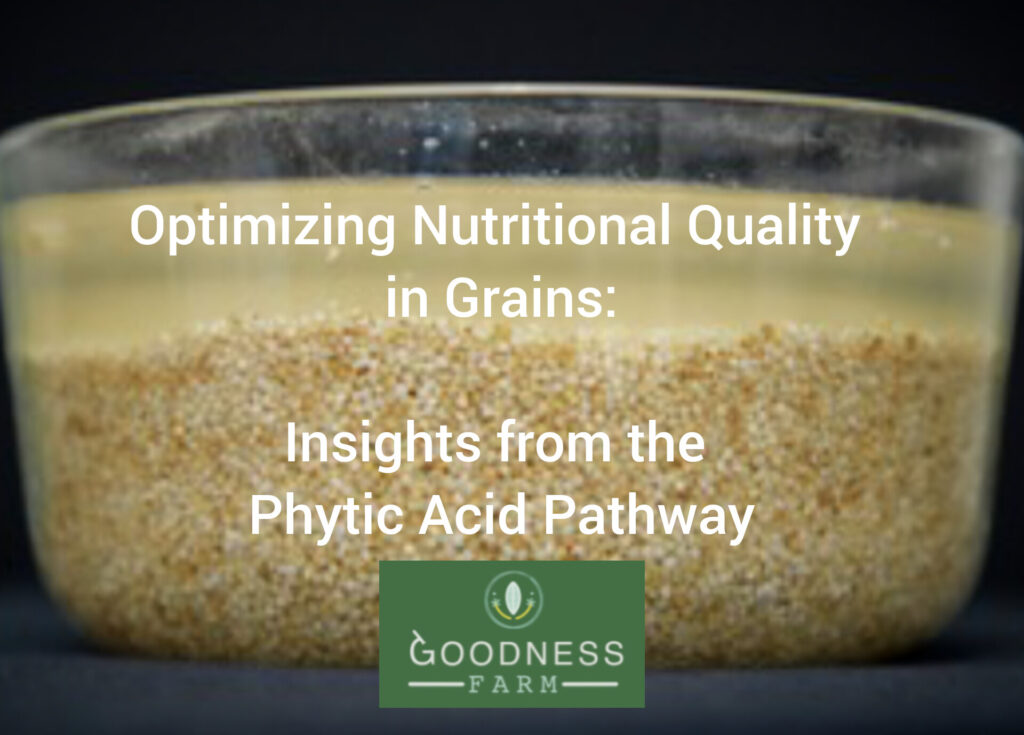Uncategorised
Optimizing Nutritional Quality in Grains: Insights from the Phytic Acid Pathway
Introduction to Antinutrients and the Role of Phytic Acid
Antinutrients are naturally occurring compounds found in various plant-based foods, including grains, legumes, and seeds. While these compounds serve important functions in plants, such as deterring pests and protecting nutrients during seed development, they can pose challenges for human nutrition. Antinutrients interfere with the absorption of essential nutrients, including minerals, proteins, and vitamins, by forming complexes that are difficult for the human digestive system to break down.
Among the various antinutrients present in grains, phytic acid (or phytate) is particularly notable for its strong mineral-binding properties. Even in small amounts—typically ranging from 1 to 3% of the grain’s dry weight—phytic acid can chelate (bind) essential minerals like iron, zinc, calcium, and magnesium. This binding significantly reduces the bioavailability of these nutrients, potentially leading to deficiencies if grains form a major part of the diet.
Given the impact of phytic acid on nutrient absorption, the processing of grains to reduce its content becomes crucial. This process largely depends on the methods employed by manufacturers, who can use techniques such as soaking, sprouting, fermentation, and the use of acidic environments to activate enzymes like phytase that break down phytic acid. By carefully managing these processes, manufacturers can enhance the nutritional value of grains and make them more beneficial for consumption.
The understanding of the phytic acid (or phytate) pathway has played a crucial role in developing natural techniques to reduce antinutrients in grains and improve their nutritional quality. Here’s how this biochemical pathway has informed and guided the use of methods like soaking followed by sprout activation, sprouting, and fermentation:
- Understanding Phytic Acid and Its Impact
- Phytic Acid Structure and Function:
- Phytic acid is a naturally occurring compound found in plant seeds, especially in grains and legumes. It serves as the principal storage form of phosphorus, essential for seed development.
- However, phytic acid is also recognized as a major antinutrient because it strongly binds essential minerals such as iron, zinc, calcium, and magnesium, forming insoluble complexes that the human digestive system cannot easily absorb.
- Nutritional Challenge:
- The presence of phytic acid in grains poses a challenge to nutrition because it reduces the bioavailability of these vital minerals, potentially leading to deficiencies, especially in populations that rely heavily on grains as staple foods.
- Phytic Acid Structure and Function:
- Insights from the Phytic Acid Pathway
- Enzymatic Breakdown of Phytic Acid:
- Research into the phytic acid pathway has revealed that phytase, an enzyme present in grains, can hydrolyze phytic acid into inositol and free phosphate, thus releasing the bound minerals and reducing the antinutrient effects.
- Phytase Activity in Grains:
- Phytase is naturally present in grains but is mostly inactive in dry seeds. However, under certain conditions—such as soaking, sprouting, and fermentation—phytase becomes activated and begins breaking down phytic acid.
- Enzymatic Breakdown of Phytic Acid:
- Application of Techniques Based on Phytic Acid Pathway Knowledge
- Soaking:
- Activation of Phytase:
Understanding that phytase can be activated by moisture has led to the practice of soaking grains. This method allows for the breakdown of phytic acid even before cooking, increasing mineral availability in the final food product. Soaking & RINSING IS MUST
- Activation of Phytase:
- Sprout Activation and Sprouting:
- Enhanced Phytase Activity:
Sprouting grains mimics the natural germination process, during which phytase activity is significantly heightened. The breakdown of phytic acid during sprouting is one of the reasons why sprouted grains are often considered more nutritious.
- Enhanced Phytase Activity:
- Fermentation:
- Phytase from Microorganisms:
The study of the phytic acid pathway also highlighted that certain microorganisms, like those involved in fermentation, produce phytase. This has led to the development of fermentation techniques, such as those used in sourdough bread making, where the microbial phytase helps reduce phytic acid content.
- Phytase from Microorganisms:
- Using an Acidic Medium:
- Increased Phytase Activity in Acidic Conditions:
It has been observed that phytase is more active in slightly acidic conditions. This knowledge has informed the practice of adding acidic substances like lime juice during soaking, which helps create an optimal environment for phytase to function and break down phytic acid.
- Increased Phytase Activity in Acidic Conditions:
- Soaking:
- Broader Implications for Food Processing
- Nutritional Enhancement:
- The insights gained from studying the phytic acid pathway have not only led to effective methods to reduce antinutrients but have also guided the development of food processing techniques that enhance the overall nutritional profile of grains.
- Nutritional Enhancement:
Conclusion The study of the phytic acid pathway has been instrumental in understanding how to reduce the antinutrient effects of phytic acid in grains. By leveraging the natural processes of soaking, sprouting, fermentation, and using acidic environments, we can enhance mineral bioavailability and improve the nutritional quality of grain-based foods. This application of biochemical knowledge underscores the importance of integrating science with traditional food processing techniques to promote better health outcomes.
At Goodness Farm, we prioritize the nutritional quality of our grains by using carefully optimized processing methods. We start with a soaking process that involves adding lime juice to create a slightly acidic environment. This acidity helps activate the enzyme phytase, which breaks down phytic acid and releases the bound minerals, making them more bioavailable. This processing methodology is patented by Dr. Maria Jenita and Team at Anna University.
After soaking, we proceed with sprout activation, where the grains are encouraged to begin germination. This sprouting process further enhances phytase activity, significantly reducing the antinutrient content and improving the overall nutritional profile of the grains. By combining these traditional and scientifically informed techniques, we ensure that our products offer maximum health benefits.

Discover more from Goodness Farm
Subscribe to get the latest posts sent to your email.
